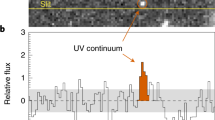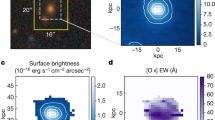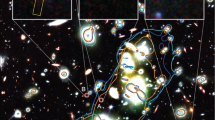Abstract
We report here the discovery of an extremely red IR source in the nucleus of the elliptical galaxy IC5063 (PKS2048 – 57). The observed (2.2–3.8) µm colour index within a 5 arc s aperture is 2.1 mag while the colours at shorter wavelengths and in the 5–10 arc s annulus around the nucleus are close to those of normal elliptical galaxies. The IR excess could arise from a BL LAC type nucleus with a steep non-thermal spectrum (α ∼ −4.5 defined by F α vα), similar to the recently identified ‘red QSOs’ typified by 1413 + 135 (refs 1, 2).
This is a preview of subscription content, access via your institution
Access options
Subscribe to this journal
Receive 51 print issues and online access
$199.00 per year
only $3.90 per issue
Buy this article
- Purchase on Springer Link
- Instant access to full article PDF
Prices may be subject to local taxes which are calculated during checkout
Similar content being viewed by others
References
Bregman, J. N. et al. Nature 293, 714–717 (1981).
Beichman, C. A. et al. Nature 293, 711–713 (1981).
Urich, M. H. et al. Astrophys. J. 198, 261–266 (1975).
Bailey, J. et al. Mon. Not. R. astr. Soc. 197, 627–632 (1981).
Disney, M. J. & Wall, J. V. Mon. Not. R. astr. Soc. 179, 235–254 (1977).
Condon, J. J. & Dressel, L. L. Astrophys. J. 221, 456–469 (1978).
Rieke, G. H. & Low, F. J. Astrophys. J. Lett. 176, L95–100 (1972).
Rieke, G. H. et al. Astrophys. J. Lett. 252, L53–L56 (1982).
Puschell, J. J. Astrophys. J. 247, 48–51 (1981).
Fosbury, R. A. E. et al. Mon. Not. R. astr. Soc. 183, 549–568 (1978).
Fosbury, R. A. E. ESO Messenger 21, 11–13 (1980).
Danziger, I. J. et al. Mon. Not. R. astr. Soc. 196, 845–856 (1981).
Caldwell, N. & Phillips, M. M. Astrophys. J. 244, 447–457 (1981).
Jones, T. J. & Hyland, A. R. Mon. Not. R. astr. Soc. 192, 359–364 (1980).
Frogel, J. A. et al. Astrophys. J. 220, 75–97 (1978).
Wade, R. A. thesis, California Institute of Technology (1980).
Reike, G. H. et al. Astrophys. J. Lett. 232, L157–L154 (1979).
Beichman, C. A. et al. Astrophys. J. 247, 780–786 (1981).
Impey, C. D. & Brand, P. W. J. L. Nature 292, 814–816 (1981).
Reike, G. H. & Lebofsky, M. J. Nature 284, 410–412 (1980).
Cutri, R. M. et al. Astrophys. J. 245, 818–828 (1981).
Author information
Authors and Affiliations
Rights and permissions
About this article
Cite this article
Axon, D., Bailey, J. & Hough, J. Discovery of a very red nucleus in the radio elliptical IC5063 (PKS2048 – 57). Nature 299, 234–236 (1982). https://doi.org/10.1038/299234a0
Received:
Accepted:
Issue Date:
DOI: https://doi.org/10.1038/299234a0
This article is cited by
-
Hidden broad line regions and anisotropy in AGN
Astrophysics and Space Science (1994)
-
Infrared polarimetry of the nucleus of Centaurus A: the nearest blazar?
Nature (1986)
Comments
By submitting a comment you agree to abide by our Terms and Community Guidelines. If you find something abusive or that does not comply with our terms or guidelines please flag it as inappropriate.



